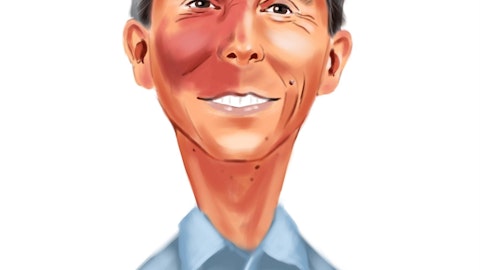Frank Riddick: Yes, there was a re-class went back several quarters we discovered there was a error and interpreting one of our contracts and allocating the funds between the linear TV part of the deal and the network or streaming part of the deal. It was just a calculation error we went back and corrected that, and we stated the periods. It had about a $10 million impact in period. So no change in bottom line revenue to media. With respect to I think to your point, we look at our cash flow characteristics of the business, it’s quite strong. And based on our assumptions about the rights renewal will continue to grow. And once we get past, the investment in the headquarter will generate a significant amount of free cash. And if nothing comes out of the strategic alternatives process that is pursued, we have a number of growth initiatives primarily related to building an experiential new PC growth in the international area, and we’ll be starting some of that in the fourth quarter and launching a new NXT Europe touring program.
Looking at doing more monetization of our IP, both our talent IP as well as some of our other IP. Nick refers to it as marvelization of WWE. Those are the key areas of investment, and we see lots of opportunity. And to the extent that we don’t have investments in growth that we think generate the right rate of return, we will return funds to shareholders. Do you want to add anything to that, Nick?
Nick Khan: Yes, just your comment about more firepower, we like that. So let’s see how it all shakes out.
Jason Bazinet: Okay, very good. Thank you.
Nick Khan: Thanks.
Operator: And we’ll take a question from David Karnovsky with JPMorgan.
David Karnovsky: Hi, thank you. Nick, maybe to ask the prior NXT question a different way. Is it important to position that content for potential buyers of Raw and SmackDown just given the synergy of running multiple nights of wrestling with one partner? Or is this kind of a totally separate process? And then one for Frank, record content, the quarter-over-quarter increase was a bit less than we’re used to seeing in the fourth quarter when you cycle into another year on your domestic deals. I’m not sure if that was related to the number of shows or some content moving to cable in the quarter. I just wanted to see if you add more color there.
Frank Riddick: Yes. Just €“ I’ll take the first one €“ the last one first is yes, we had €“ it’s really just timing of shows in the quarter on a year-over-year basis. You should expect to see the normal escalation quarter-over-quarter until we enter into a new contract for those rights.
Nick Khan: And in terms of NXT, look, we’re really happy with our NBCU partnership. So allow me to articulate a couple of reasons why. If we do a premium live event on a Saturday, and NBC has Sunday Night Football, obviously, on Sundays for 18 weeks or whatever their full regular season packages. We get a lot of promotion out of those two enterprises to Raw on Monday, which promotes a lot to NXT on Tuesday, which all of those promote to SmackDown on Friday on Fox. So we like the way that, that cadence has worked. That being said, this past €“ the past winter Olympics, so February of last year, we were preempted on USA on Raw. I know you’re asking about NXT. We were preempted in short order on Raw and moved to Syfy. Raw carried 90% of its audience in both the demo and the overall audience from USA to Syfy, again, with very short notice.
So we’re pleased with what we can do on any platform, any network with our programming with again, it having worked quite well at NBCU.
David Karnovsky: Thank you.
Seth Zaslow: Justin, we’ll take one last question, please.
Operator: Thank you. That question will come from Alan Gould with Loop Capital.
Alan Gould: Thanks for taking the question. Nick, I was really impressed with the fact that the young demos are doing so well on Raw. How important is traditional TV for your overall fan engagement when you look at TV versus streaming versus digital these days or.
Nick Khan: Look, it’s still important, but it’s certainly not as important. We don’t think to anyone as it once was. So the TV Everywhere notion is something that we like even if you look at the Peacock numbers, a lot of those are on mobile devices. So we like people being able to watch what they want to watch, when they want to watch it. So if you look at the way that we certainly designed it for this right cycle. You have one program on broadcast SmackDown, you have one on basic cable Raw and you have our premium live events on streaming with Peacock. We think all three have worked. So as it goes into the new cycle, again, Fox is traditional broadcast in terms of free-to-air. We love it. It’s worked. In terms of USA, it continues to work.
They’re obviously a long-time partner of ours. And in terms of where the young audience is, we want to make sure we don’t miss that. So a renewed energy focusing on that young audience we think is part of the reason why you see that spike on Raw in the 18 to 34 demo, and we want to keep all of that up.
Alan Gould: Great.
Nick Khan: Thanks, Alan.
Seth Zaslow: Thank you, everyone, for joining us today. Justin, you can conclude the call now, please.
Operator: Thank you. That does conclude today’s conference. We do thank you for your participation. Have an excellent day.
Follow World Wrestling Entertainment Llc (NYSE:WWE)
Follow World Wrestling Entertainment Llc (NYSE:WWE)
Receive real-time insider trading and news alerts





